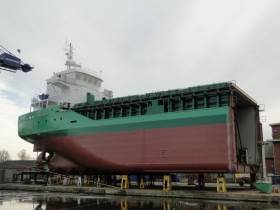Displaying items by tag: London Port Authority
Irish Green and Dutch Orange Newbuilds Meet At Port of London
#ArklowThames - This week Afloat reported on stories from the Strait of Dover and it is on the other side of the Kent coast that a new ship, part of the Arklow Shipping fleet was until yesterday at anchorage, writes Jehan Ashmore.
The newbuild Arklow Valour (2017/5,158dwt) is the fifth completed ‘V’ class dry-cargoship.The vessel had anchored off Margate on the north Kent coast before sailing last night to the Port of London. Arklow Valour was within the first hour of this month moored alongside Conways Berth at Erith.
Arklow Valour is under the Dutch flag and is managed by Arklow Shipping Nederland B.V. based in Rotterdam. While upriver and opposite Tilbury Docks, a fleetmate but this time Irish flagged, Arklow Cadet (2016/5,085dwt) of Arklow Shipping Ltd was berthed at Bevans Wharf at Northfleet. The ship had sailed from Belfast Harbour.
Both newbuilds are 87m long and were allotted berths on the south bank by the Port of London Authority. The PLA are responsible for operations covering 95 miles of the River Thames. In addition to maintaining commercial and leisure users safe, the protection and enhancement of the environment and promotion of trade and travel.
Last month, Arklow Valour had been towed from the inland shipyard of Royal Bodewes at Hoogezand along the canal to Delfzijl to enter the sea. At Westerbroek which is nearby to Hoogezand is the German owned yard of Frus-Smit that completed Arklow Cadet last year. The vessel is the first in a series of ‘C’ class cargoships.
It is at Delfzijl, a port on the Ems Estuary, that by a series of coincidences there has been recent focus on Irish shipping news stories. In addition to that of recent years, notably given all the newbuilds ordered by Arklow Shipping that have been built in this region.
Also in the coverage of these newbuilds have been the ships entering to the sea for the first time to carry out sea trials. These trials are also conducted from Emeshaven (including Arklow Valour) which is located outside of the estuary on the North Sea.
As alluded in the introduction, the Strait of Dover, is where on Monday the bitumen tanker, Iver Ability (former long-stay Dublin Bay anchorage caller) transited the world’s busiest shipping channel. The 12,497dwt Iver Ability had departed Irish waters bound for Delfzijl, but as reported yesterday was and currently remains at anchorage in Dutch waters.
Also reported at Delfzijl is where Corrib Shipping Group are now providing ship management of the Ziltborg. The 7,200dwt general cargosship was renamed for Dutch based owners, Wagenborg.
Ziltborg remains at the port but in a floating drydock having undergone work including repainting of company colours. The Dublin based group expect the new addition to enter service within weeks.
























































